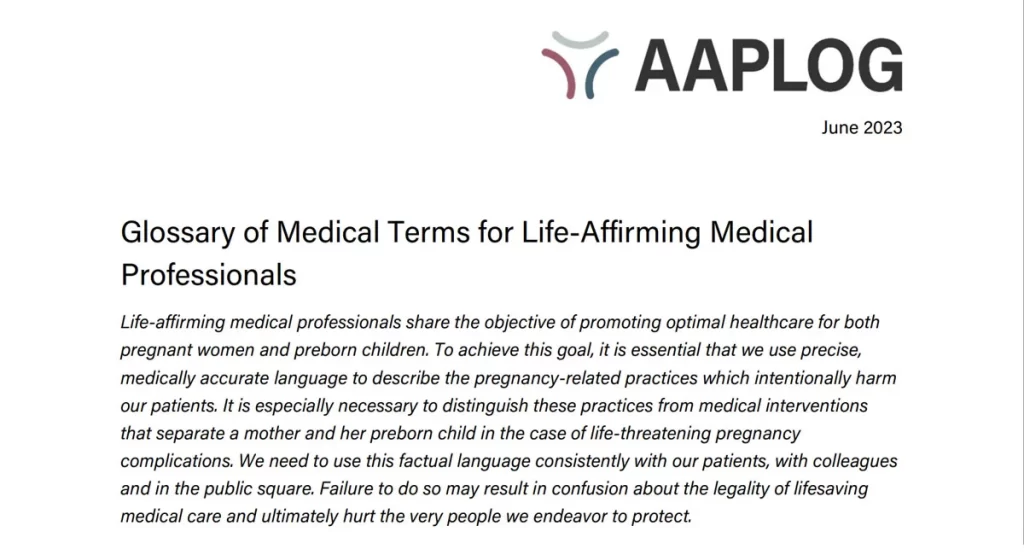AAPLOG’s Glossary of Medical Terms, published in the summer of 2023, seems to be striking a nerve among pro-abortion advocates. The American College of Obstetricians and Gynecologists (ACOG) has published an update to their “Guide to Language and Abortion” responding to a term from this glossary that offers an important distinction between induced abortion and lifesaving treatments for serious pregnancy complications.
Their updated document lists the term “maternal-fetal separation” among the language marked “terms to avoid”, claiming that it is “misleading”. Let’s unpack the claims they make in their single-paragraph objection to the use of this term.
- ACOG denies the distinction between induced abortion and medically indicated pregnancy interventions.
The language guide repeatedly claims that the term “maternal-fetal separation” makes a false distinction between induced abortion and lifesaving pregnancy interventions. But their own website defines induced abortion as “a medical intervention that ends a pregnancy such that it does not result in a live birth.” This means that in order to qualify as an induced abortion, a medical intervention must both (1) end a pregnancy and (2) do so in a way that intends the death of the fetus or embryo. There are many interventions, such as miscarriage management, C-sections, and inductions of labor, that do not fall under this definition, even if they do not result in a live birth.
- ACOG makes contradictory claims about the existence of alternatives to induced abortion.
In one sentence, ACOG objects to the use of the term “maternal-fetal separation” because it is used to claim “that there is a medical intervention that is an alternative to abortion” — implying that there are no alternatives to induced abortion in the case of life-threatening pregnancy complications, or that the alleged alternatives are just other examples of induced abortion. In the next sentence, however, ACOG criticizes pro-life advocates for using this term “to justify or mandate using medical procedures that carry more risk for the patient, such as caesarian section or induction of labor, rather than abortion” — implying that there is such a thing as alternatives to induced abortion (namely, C-section or labor induction). In addition to the fact that they are ignoring the inherent dangers of abortion procedures later in pregnancy, it’s important to point out that it cannot both be the case that (1) there is no such thing as an alternative to induced abortion and (2) there are alternatives to induced abortion that are more dangerous for patients.
- ACOG appears misinformed about how abortion data is collected.
Their language guide claims that using the term “maternal-fetal separation” “potentially complicates the gathering of critical data related to maternal health.” In fact, making a clear distinction between induced abortion and lifesaving pregnancy interventions is most in line with how abortion data is currently gathered. In its abortion surveillance system, the CDC states that its definition of abortion “excludes management of known intrauterine fetal death, early pregnancy failure or loss, ectopic pregnancy, or retained products of conception.” By attempting to include all these medical interventions in their definition of abortion, it is ACOG that would complicate how maternal health data is gathered – artificially inflating the number of abortions performed in this country to falsely claim that induced abortion is essential healthcare.
- ACOG conflates miscarriage management with induced abortion.
The paragraph disputes the notion that one can “contend that a ‘maternal-fetal separation’ is a different or separate option for pregnant people who need an abortion, including miscarriage management” (emphasis added). Let us remind ACOG of their own definition of “induced abortion”: “a medical intervention that ends a pregnancy such that it does not result in a live birth.” Per this definition, miscarriage management cannot be the same thing as induced abortion because if a patient is having a miscarriage, her pregnancy has ended or is ending – resulting in fetal or embryonic demise – from natural causes, without medical intervention. Miscarriage management does not end that pregnancy but rather ensures that the miscarriage is resolved safely without complications.
Conflating miscarriage management with induced abortion perpetuates stigma, shame, and confusion surrounding pregnancy loss. It is not an uncommon occurrence for patients to call their physician after treatment for a miscarriage, distraught because they saw the word “spontaneous abortion” on their discharge paperwork – causing significant distress because they are opposed to induced abortion. Of course, these are two very different things; all medical professionals understand this, and it is our duty to be sure we are using clear language with our patients so as not to worsen their emotional and mental distress and so they clearly understand what was done. Updating our terminology to reflect the important difference between miscarriage management and induced abortion is most in line with sound patient care.
ACOG’s conflation of induced abortion with miscarriage management is not only medically incoherent; it’s also legally false. Every pro-life state law in the country makes a distinction between miscarriage management and induced abortion; for example, Texas explicitly excludes miscarriage management from its definition of abortion. (More on this in the next story.)
We strongly encourage members to respond to ACOG’s updated language guide. If you are an ACOG member and have received their recent e-newsletter announcing this update, we encourage you to respond to that email so ACOG knows that they do not represent you when they elevate their pro-abortion agenda above sound patient care.






